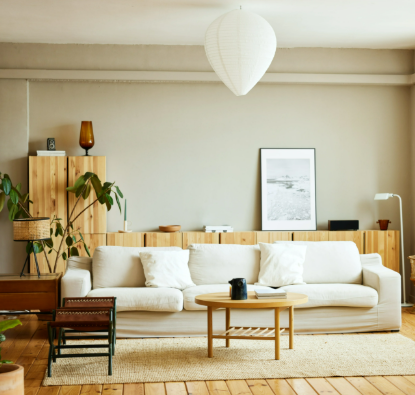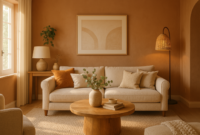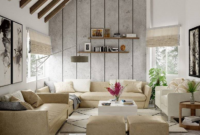Scandinavian Style
The term Scandinavian style conjures images of sleek minimalism, natural light, warm textures, and a profound connection to nature. Originating from the Nordic countries—Sweden, Denmark, Norway, Finland, and Iceland—this design philosophy has transcended borders, becoming one of the most influential and beloved interior design trends globally. But Scandinavian style isn’t just about aesthetics. It’s deeply rooted in cultural values such as simplicity, functionality, and the pursuit of coziness, or hygge, a Danish word that roughly translates to “a feeling of comfort and contentment.”
This article will delve into the history, core principles, and various elements of Scandinavian design. We’ll also explore how you can bring this timeless style into your own home, regardless of your geography.
A Brief History of Scandinavian Design
Scandinavian design emerged in the early 20th century, gaining international acclaim in the 1950s. It was part of a broader modernist movement that emphasized function, affordability, and democratic access to beautiful, well-made products. Influential designers like Alvar Aalto, Arne Jacobsen, and Hans Wegner spearheaded this approach by creating furniture and everyday items that were not only aesthetically pleasing but also highly practical.
The cold, dark winters in Nordic countries significantly shaped the style. Long hours without sunlight led to a preference for light colors and open spaces, helping to create bright, airy interiors. Additionally, the scarcity of natural resources fostered a culture of minimalism and sustainability. As such, Scandinavian design champions quality over quantity, often showcasing a “less is more” approach.
Core Principles of Scandinavian Style
1. Simplicity
Scandinavian interiors are known for their clean lines, clutter-free spaces, and restrained color palettes. Every item has a purpose, and the design avoids unnecessary embellishments. This simplicity extends to architecture, furniture, and even lifestyle choices.
2. Functionality
Form always follows function in Scandinavian design. Furniture and home accessories are designed to be practical first and foremost. Multifunctional pieces, such as sofa beds or extendable dining tables, are common, especially in small urban apartments.
3. Natural Materials
Nature plays a central role in Nordic life, and that connection is reflected in their interiors. Wood—particularly light varieties like pine, birch, and oak—is used extensively. Textiles such as wool, linen, and cotton add warmth and texture.
4. Neutral Color Palettes
The hallmark of Scandinavian interiors is the use of whites, grays, beiges, and soft pastels. These colors reflect natural light and help to open up the space, making rooms feel larger and more inviting.
5. Light and Space
Maximizing natural light is crucial in Scandinavian homes. Large windows, minimal window treatments, and strategically placed mirrors help to brighten interiors. Open-plan layouts are preferred to enhance the sense of flow and space.
6. Cozy Elements (Hygge)
Despite its minimalist backbone, Scandinavian design never feels cold. This warmth comes from hygge—a cultural concept that emphasizes comfort and well-being. Candles, soft throws, textured rugs, and warm wood tones create a welcoming atmosphere.
Key Elements of Scandinavian Interior Design
Furniture
Scandinavian furniture is characterized by its simple yet elegant lines. Iconic pieces include the Egg Chair by Arne Jacobsen and the Wishbone Chair by Hans Wegner. Flat-pack furniture brands like IKEA have popularized the style globally, offering affordable and functional designs.
Most Scandinavian furniture pieces are made of wood and often feature tapered legs and gentle curves. Upholstered items come in muted tones, while storage units are sleek and unobtrusive.
Flooring
Carpets are rarely used in Scandinavian interiors. Instead, wooden flooring—often painted white or left in a natural finish—dominates. Area rugs made from wool or sheepskin are used sparingly to add texture and warmth.
Lighting
Given the limited daylight in Nordic countries, artificial lighting is critical. Scandinavian interiors often feature a mix of ambient, task, and accent lighting. Pendant lamps, floor lamps, and wall sconces with minimalist designs are common. Candles are also a vital part of creating a cozy ambiance.
Textiles
From chunky knit throws to linen drapes, textiles soften the otherwise clean and structured elements of Scandinavian design. Patterns tend to be subtle—think stripes, checks, and botanical prints. In the winter, heavier materials like wool and fleece make spaces feel snug and insulated.
Accessories and Decor
Decor is minimal yet impactful. Houseplants, ceramics, and framed prints provide personality without cluttering the space. Wall art usually features nature scenes, abstract graphics, or monochrome photography. Storage baskets made from natural materials like rattan or seagrass help keep things tidy while adding visual interest.
Scandinavian Design Across Different Rooms
Living Room
The heart of the home, the Scandinavian living room is all about comfort and functionality. A neutral color scheme sets the tone, while soft furnishings, wood accents, and natural lighting enhance the feeling of relaxation. Modular sofas, floating shelves, and minimalist coffee tables make the space practical yet stylish.
Bedroom
Scandinavian bedrooms are tranquil retreats. Crisp white bedding, a light wooden bed frame, and a few carefully chosen accessories create a serene environment. Storage solutions are often built-in to maintain a clean look. Blackout curtains or light-filtering blinds are used to manage the unique lighting conditions of Nordic regions.
Kitchen
Scandinavian kitchens are clean, efficient, and inviting. White cabinetry, open shelving, and natural wood countertops are typical. Functionality is key—appliances are often integrated to maintain a seamless look. Simple pendant lights and plants or herbs on the windowsill add a touch of life and character.
Bathroom
In Scandinavian bathrooms, you’ll often find a monochrome palette, minimalist fixtures, and plenty of natural materials like stone or wood-look tiles. Storage is smart and streamlined. Details like plush towels, woven baskets, and matte black or brass fittings add personality without disrupting the calm aesthetic.
Scandinavian Style Beyond the Home
The influence of Scandinavian style isn’t limited to interiors. Its principles extend to fashion, graphic design, product design, and even urban planning. Sustainability, functionality, and understated beauty are common threads. Cities like Copenhagen and Stockholm reflect these ideals in their bike-friendly streets, public spaces, and architecture.

Scandinavian-Inspired Lifestyle Choices
Many who embrace the Scandinavian aesthetic in their homes also adopt elements of Nordic lifestyle philosophies. Concepts like lagom (Swedish for “just the right amount”) and friluftsliv (Norwegian for “open-air living”) encourage balance, mindfulness, and connection with nature. These principles can lead to a more harmonious and grounded way of living.
How to Incorporate Scandinavian Style in Your Own Home
You don’t need to live in Northern Europe to bring Scandinavian style into your life. Here are a few practical tips:
-
Declutter Your Space: Start by removing unnecessary items. Keep only what you use and love.
-
Choose a Neutral Base: Use white, gray, or beige for walls and large furniture pieces. Add interest with textures rather than colors.
-
Invest in Quality Over Quantity: Opt for fewer but better-made items that will last.
-
Incorporate Natural Elements: Use wood, stone, and plant life to add warmth and authenticity.
-
Focus on Lighting: Use a variety of light sources to create ambiance. Don’t forget the power of candles!
-
Layer Textures: Mix soft furnishings—like linen, wool, and cotton—for a cozy feel.
-
Celebrate Simplicity: Let each piece of furniture or decor have space to shine. Embrace minimalism.
Final Thoughts
Scandinavian style is more than just a design trend—it’s a reflection of a lifestyle rooted in balance, comfort, and respect for nature. Its enduring popularity lies in its ability to be both beautiful and practical, minimalist yet inviting. Whether you’re redesigning your home or simply looking to create a more peaceful and functional environment, Scandinavian design offers a timeless and meaningful approach.
As the world becomes increasingly fast-paced and cluttered, the calm and clarity offered by Scandinavian interiors serve as a welcome retreat. By adopting even a few of its principles, you can bring more light, warmth, and purpose into your everyday life.


